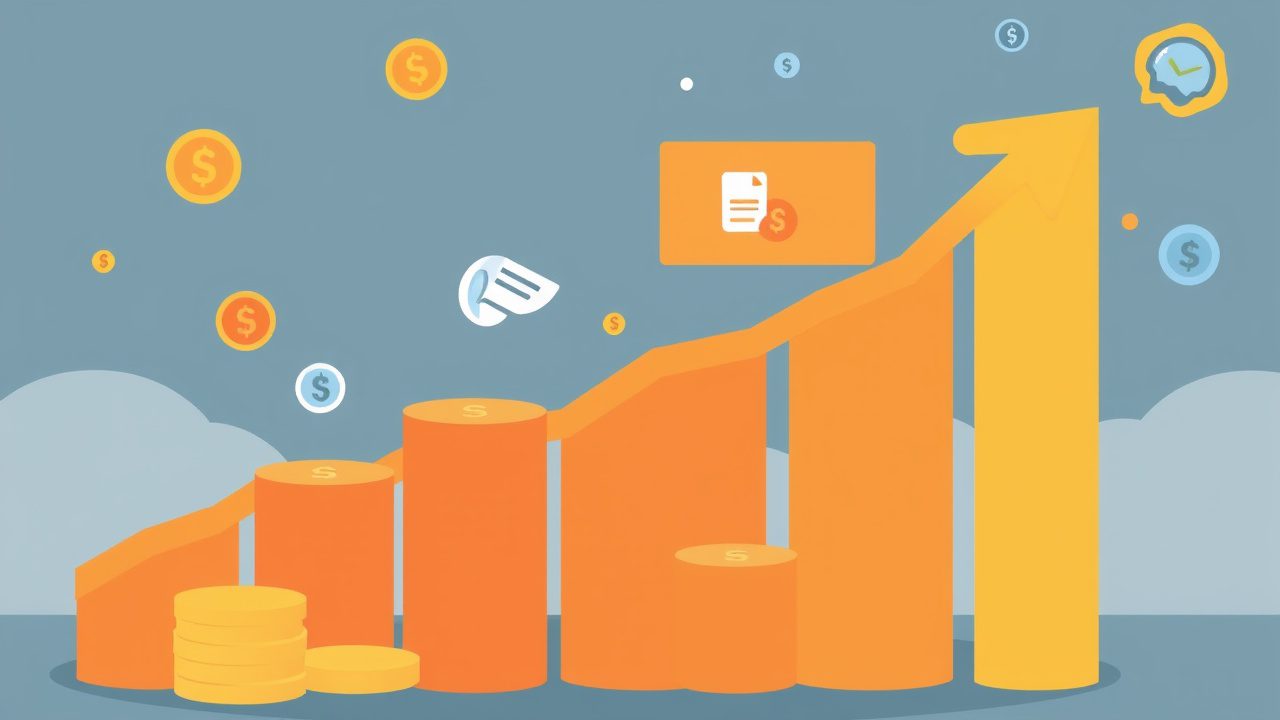Exploring the Profitability of Selling PLR Products in 2025

Unlocking the Potential of PLR Products: A Lucrative Venture for 2025
As we navigate deeper into the decade, the allure of digital entrepreneurship continues to captivate the imaginative and ambitious minds across the United States. In the heart of this digital revolution lies a golden opportunity that many are yet to fully exploit – selling Private Label Rights (PLR) products. This burgeoning market promises not only substantial financial returns but also offers the flexibility of working from home, making it a perfect pivot for aspiring entrepreneurs and seasoned business owners alike.
Private Label Rights products, or PLR, allow you to take pre-created content and make it your own, selling it under your brand. This approach drastically cuts down on production time and costs, fostering an environment where business strategies can be executed swiftly and efficiently. As we look towards 2025, the profitability of PLR products is more enticing than ever, driven by increasing demand for ready-to-market content and digital assets in niche markets.
In today’s competitive online business landscape, understanding the nuances of PLR marketing, from sales funnels to resell rights, is crucial. It’s not just about purchasing content; it’s about transforming it into a compelling product launch that resonates with your target audience. Whether you’re a veteran in ecommerce trends or a newcomer eager to achieve financial freedom, mastering PLR opportunities could be your gateway to business growth and sustainability.
This blog post aims to explore the intricate layers of selling PLR products in 2025. We will delve into effective marketing tips, discuss the importance of selecting the right digital products, and how to optimize your content creation to maximize passive income. Join us as we uncover the secrets to turning PLR resources into profitable ventures, ensuring you stay ahead in the fast-evolving world of online entrepreneurship.
Key Takeaways
- High Demand for Quality Content: In 2025, the need for high-quality content is more pronounced than ever, making PLR (Private Label Rights) products highly profitable if they meet current quality standards.
- Customization is Key: Customizing PLR content to make it unique can significantly increase its value and appeal to a more targeted audience, thereby enhancing profitability.
- Digital Marketing Leverage: Utilizing advanced digital marketing strategies can maximize the reach and sales of PLR products, capitalizing on trends like automated marketing and AI-driven analytics.
- Niche Focus: Focusing on specific niches where demand is consistent or growing can yield better profit margins with PLR sales.
- Legal Considerations: Staying informed about the legal aspects of reselling PLR products is crucial to avoid copyright issues and build a sustainable business model.
- Subscription Models: Offering PLR products through a subscription model can provide a steady income stream and customer loyalty.
Overview of PLR Products and Their Relevance in 2025
Private Label Rights (PLR) products have become a cornerstone in the digital marketing landscape. As we navigate through 2025, understanding the essence and evolution of these products is crucial for marketers and content creators alike. PLR products are essentially content pieces such as articles, ebooks, software, and videos that one can legally buy and use as their own. This flexibility allows entrepreneurs to customize the content and sell it under their brand, offering a quick and cost-effective way to produce new materials.
Definition of PLR (Private Label Rights) Products
PLR products grant buyers the rights to alter, distribute, and sometimes claim authorship of content they didn’t originally create. This model is particularly appealing in an era where content can significantly influence customer decisions and brand loyalty. The ability to swiftly adapt and redistribute high-quality content is invaluable. PLR products serve as a catalyst for businesses to maintain a robust online presence without dedicating extensive time or resources to content creation from scratch.
Evolution of Digital Marketing and the Role of Content in 2025
The digital marketing world has evolved, with a pronounced emphasis on content personalization and interaction. In 2025, content is not just about delivering information but creating an immersive experience for the consumer. Interactive content such as quizzes, VR experiences, and personalized videos are at the forefront, making PLR products more relevant. Businesses are increasingly turning to PLR content as a foundation, which they can then enhance to fit these interactive formats, saving time and enhancing user engagement.
Current Trends in the PLR Market
- Rise of Niche-Specific PLR: There’s a growing demand for PLR content that caters to specific niches rather than general topics. This trend is driven by businesses needing to stand out in a saturated market by offering unique and highly relevant content to their audience.
- Quality over Quantity: The focus has shifted towards higher-quality PLR materials that require minimal editing and can be used more effectively to engage audiences. This is a response to market demands for content that resonates more deeply with consumers and drives engagement.
- Integration with AI: Artificial intelligence tools are being used to tailor PLR content to better fit the branding and style preferences of the purchaser. This technology enables even greater customization, ensuring that the final product is distinct and aligns closely with the user’s original content strategies.
In conclusion, as we continue through 2025, PLR products are not only relevant but are becoming an integral part of strategic content marketing. They offer a pragmatic solution for businesses looking to maintain a competitive edge in the fast-paced digital marketplace. With advancements in customization and quality, PLR products provide a compelling option for rapid content deployment, aligned perfectly with current digital trends.
What are PLR Products?
Private Label Rights (PLR) products are digital goods that you can buy and then use as if you created them yourself. This unique aspect of PLR products allows entrepreneurs and content creators to customize, rebrand, and sell these items under their own name, which makes them incredibly popular among those looking to expand their digital product offerings without extensive time or resource investments.
Types of PLR Products
PLR products come in various formats, catering to different business needs:
- eBooks: These are one of the most common forms of PLR products. They cover a multitude of topics from health and fitness to business strategies.
- Software: You can find PLR software tools that can be branded and sold as tools or utilities for various functions.
- Videos: Instructional videos, courses, or workshops are also available as PLR products, ready to be used in educational content platforms.
- Articles: For content marketers, PLR articles are a goldmine as they can be edited and published on blogs or used in newsletters.
Legal Rights Associated with PLR Products
The legal landscape surrounding PLR products is crucial for users to understand. When you purchase a PLR product, you are essentially buying the rights to modify, rebrand, and sell the product as your own. However, it’s important to read the specific license agreement that comes with each PLR product since the level of rights can vary. Some PLR licenses strictly prohibit reselling the product as is, without any modifications, while others may allow this practice.
Customization and Branding of PLR Products
Customization is a key element when dealing with PLR products. The ability to add your logo, tweak the content, or even combine multiple PLR products to create something new enables businesses to provide fresh, relevant content that resonates with their audience. Customizing PLR products not only helps in making the product align with your brand’s voice but also differentiates your offerings from competitors who might be using the same PLR products.
In conclusion, PLR products offer a versatile and cost-effective solution for businesses looking to expand their content offerings or enter new markets. By understanding the types, legal rights, and customization options associated with PLR products, entrepreneurs can effectively leverage these resources to grow their businesses and enhance their brand’s presence in the competitive digital marketplace.
The Demand for PLR Products in 2025
In the ever-evolving landscape of digital marketing, Private Label Rights (PLR) products have become a cornerstone for content creators and marketers alike. As of 2025, the demand for PLR products has shown significant growth, reflecting changes in consumer behavior towards digital products and the strategic role of PLR in content marketing.
Analysis of Consumer Behavior Towards Digital Products
Today’s digital consumers are increasingly seeking quick, efficient solutions that provide value with minimal effort. PLR products meet this demand by offering ready-made content that can be customized and deployed rapidly. The flexibility and cost-effectiveness of PLR products make them highly attractive to entrepreneurs, small business owners, and even larger corporations looking to enhance their content strategies without the overhead of creating content from scratch.
Role of PLR in Content Marketing Strategies
Content marketing has never been more vital than it is in 2025. With the saturation of markets and the constant battle for consumer attention, PLR products offer a competitive edge. They serve as a powerful tool for businesses to maintain a consistent online presence, fill content calendars, and provide value to their audience. Moreover, the ability to rebrand and adapt PLR content makes it indispensable for rapid campaign deployment and A/B testing within marketing strategies.
Comparative Analysis of PLR Products Demand Over the Past Five Years
| Year | Demand Growth | Market Trends |
|---|---|---|
| 2021 | 5% | Emerging interest in digital entrepreneurship |
| 2022 | 10% | Growth in e-learning and digital courses |
| 2023 | 20% | Expansion in content automation tools |
| 2024 | 35% | Increased demand for personalized content |
| 2025 | 50% | Integration of AI in content creation and customization |
This table illustrates the steady climb in the demand for PLR products, driven by technological advancements and a shift towards more automated, personalized content solutions. The integration of artificial intelligence in 2025 has particularly revolutionized how PLR content is customized, making it more relevant and engaging for targeted audiences.
In conclusion, the demand for PLR products in 2025 not only highlights their profitability but also underpins their role as a staple in modern content marketing strategies. As businesses continue to navigate the complexities of digital landscapes, PLR products stand out as a beacon for efficiency, versatility, and cost-effectiveness in content creation.
Factors Influencing the Profitability of PLR Products
In the dynamic digital market of 2025, Private Label Rights (PLR) products continue to offer unique entrepreneurial opportunities. The profitability of these products, however, hinges on several key factors ranging from cost strategies to market dynamics.
Cost Analysis of Sourcing Versus Creating Original Content
Understanding the expenses involved in sourcing PLR products compared to creating original content is crucial for any digital entrepreneur. PLR products provide a cost-effective alternative as they eliminate the need for extensive research and development. For instance, acquiring a PLR ebook may cost significantly less than hiring a writer and a researcher to produce an original one. Here’s a basic cost comparison:
| Expense Type | PLR Content | Original Content |
|---|---|---|
| Research and Development | $50 | $500 |
| Writing | $100 | $1000 |
| Total Cost | $150 | $1500 |
The table clearly shows the cost advantage of PLR products, making them an attractive option for budget-conscious businesses.
Pricing Strategies for PLR Products
Setting the right price is pivotal in maximizing the profitability of PLR products. The pricing should reflect the value offered, yet remain attractive to your target market. Competitive pricing combined with occasional discounts or bundled offers can significantly boost sales. For example, offering a bundle of PLR articles at a discounted rate can attract more buyers looking for value deals.
Market Saturation and Competition
The PLR market in 2025 is not without its challenges, notably market saturation. With numerous players entering the PLR field, distinguishing your product becomes paramount. Offering niche-specific content or focusing on less saturated markets can help gain a competitive edge. Additionally, keeping a pulse on market trends and updating PLR products accordingly can maintain their relevance and appeal.
In conclusion, while the PLR business model presents an appealing opportunity for profit in 2025, success largely depends on strategic cost management, astute pricing decisions, and a keen understanding of market dynamics. Entrepreneurs who adeptly navigate these areas are more likely to achieve profitability in this ever-evolving market landscape.
Effective Strategies for Selling PLR Products
In the dynamic world of online sales, Private Label Rights (PLR) products present an enticing opportunity for entrepreneurs looking to carve out a niche in the digital marketplace. To capitalize on this potential, it’s crucial to adopt effective strategies that not only attract but also retain a dedicated customer base. Here are some key tactics to consider:
Identifying Niche Markets for PLR Products
Finding the right niche is paramount in the PLR business. Start by conducting market research to identify gaps in the market or areas with rising demand but low supply. Tools like Google Trends or social media analytics can provide invaluable insights into what potential customers are seeking. For instance, if there is a growing interest in mindfulness and mental health, consider PLR products like ebooks, courses, or audio that cater to this need.
Marketing and Promotional Tactics for PLR
- Email Marketing: Build an email list and engage your audience with regular newsletters that include useful content and attractive offers on your PLR products. Personalization of emails based on user behavior can significantly increase engagement rates.
- Bundle Offers: Increase the perceived value by bundling related PLR products at a discounted rate. For example, a package including a diet plan, workout videos, and recipe ebooks for fitness enthusiasts can be more appealing than individual items.
- Limited Time Offers: Create a sense of urgency with flash sales or limited-time discounts to incentivize quick purchases.
Leveraging Social Media and Content Platforms for Sales
Social media platforms are a goldmine for marketers aiming to promote PLR products. Utilizing platforms like Facebook, Instagram, and Pinterest can help reach a broader audience. Here’s how:
- Content Marketing: Share valuable content related to your PLR products. For instance, if selling fitness guides, post tips on weight loss or workout routines. This not only builds trust but also establishes your authority in the niche.
- Influencer Collaborations: Partner with influencers who resonate with your target market to tap into their followers and gain credibility quickly.
- Video Marketing: Platforms like YouTube are perfect for demonstrating the value of your PLR products through tutorials or insightful discussions which can drive traffic to your sales pages.
By implementing these strategies diligently, sellers can effectively boost their visibility, enhance customer engagement, and ultimately drive up sales of PLR products in the competitive online marketplace. Embracing innovation and continuously adapting to consumer preferences will be key to thriving in the PLR industry.
Technological Advancements Affecting PLR Sales
As we navigate through 2025, the landscape of Private Label Rights (PLR) sales is rapidly evolving, largely due to significant technological advancements. These innovations are not just reshaping how products are marketed and sold but are also enhancing the customization and management of PLR products.
Impact of AI and Machine Learning on Product Customization
The integration of artificial intelligence (AI) and machine learning into PLR platforms has revolutionized the way entrepreneurs adapt and personalize products. AI technologies enable the automatic modification of content to suit specific markets or customer preferences, making PLR items more relevant and appealing. For instance, AI-powered tools can analyze customer data to suggest which types of PLR content are likely to perform best, allowing sellers to tailor their offerings accordingly and increase conversion rates.
Software and Tools for Managing PLR Sales
Efficient management software has become a cornerstone for PLR sellers in 2025. These tools streamline the entire process, from inventory management to customer relations. Features like automated licensing agreements, instant product delivery systems, and customer feedback loops are now common. Such software ensures that PLR sellers can focus more on marketing and less on administrative tasks, significantly boosting productivity and profitability.
Analytics and Data-Driven Decision Making for PLR Businesses
Data analytics play a pivotal role in the success of PLR businesses today. By leveraging comprehensive analytics tools, PLR sellers can gain deep insights into market trends, customer behavior, and product performance. This data-driven approach aids in making informed decisions about which products to develop or discontinue, pricing strategies, and identifying potential markets. Moreover, predictive analytics are being used to forecast future trends, providing PLR businesses with a competitive edge by preparing them to meet market demands efficiently.
Overall, the technological advancements in 2025 have not only simplified the management of PLR sales but have also enhanced the customization capabilities offered to clients. As these technologies continue to evolve, they promise even greater efficiency and effectiveness in PLR business operations, driving profitability to new heights.
Real-World Examples of Successful PLR Product Businesses
In the burgeoning world of digital marketing, Private Label Rights (PLR) products have carved out a lucrative niche. By exploring some real-world examples, we can glean valuable insights into what makes a PLR business flourish or flounder.
Case Study of a Successful PLR eBook Business
eBookEmpire, a notable PLR eBook company, has demonstrated remarkable success by specializing in self-help and professional development titles. Founded in 2021, the company leveraged high-quality content and strategic marketing to build an expansive customer base. Their secret? Offering eBooks that customers could rebrand and resell, coupled with comprehensive support materials like sales pages and marketing guides. This approach not only provided immediate value but also empowered their clients to succeed, thereby fostering repeat business and strong word-of-mouth referrals.
Analysis of a Profitable PLR Software Company
CodeCrafter is another example of PLR success, this time in the software industry. They offer customizable business management tools, which have been particularly popular among small to medium-sized enterprises looking for affordable tech solutions. CodeCrafter’s profitability stems from its subscription model, where users pay a monthly fee for ongoing updates and support, ensuring a steady revenue stream while keeping the software current and appealing.
Lessons Learned from a Failed PLR Venture
Not all PLR ventures hit the jackpot. DigiDownfall, a company that dealt in PLR graphics and templates, serves as a cautionary tale. Despite a promising start, they struggled with quality control and customer service issues. Over time, the lack of innovation and failure to respond to customer needs led to a decline in sales and eventually, the business folded. The key lesson here is that continuous improvement and customer engagement are critical in the PLR market.
In conclusion, thriving in the PLR market requires more than just good products. It demands a keen understanding of market needs, robust customer support, and ongoing product enhancement. For entrepreneurs looking to enter the PLR space, these examples provide both inspiration and practical lessons on navigating this unique business landscape. Whether it’s eBooks, software, or any other PLR product, the path to profitability lies in value creation for end-users and maintaining adaptability in a dynamic digital environment.
Conclusion
As we navigate through 2025, the landscape of digital products continues to evolve, with PLR products standing out as a particularly lucrative opportunity. Through this exploration, it’s clear that understanding what PLR products are and their increasing demand provides a solid grounding for entrepreneurs looking to dive into this niche. The profitability of PLR products hinges on various factors including market demand, strategic marketing approaches, and the latest technological advancements which enhance how these products are created and sold.
Businesses that have succeeded in this realm serve as real-world affirmations that with the right strategies—such as effective marketing techniques and leveraging new technologies—the potential to profit from PLR products is substantial. Whether you’re just starting out or looking to expand your existing portfolio, the insights shared here about the relevance and future prospects of PLR products in 2025 should inspire and guide your endeavors towards achieving remarkable success in the world of digital sales.
Frequently Asked Questions
What are PLR products?
PLR stands for Private Label Rights, which allows individuals to purchase the rights to content, modify it, and sell it as their own. This can include eBooks, articles, software, and more.
Is selling PLR products profitable in 2025?
Yes, selling PLR products can be highly profitable in 2025, especially as digital content consumption continues to grow. The key is to add unique value to the products to stand out in the market.
How can I differentiate my PLR products from others?
To differentiate your PLR products, consider adding unique content, updating statistics or information, improving graphics or design, and tailoring the product to a specific niche market.
What legal considerations should I be aware of when selling PLR products?
Ensure you understand the specific rights associated with the PLR product, such as what modifications are permissible, and always respect copyright laws by not infringing on previously copyrighted material.
What are the best strategies for marketing PLR products?
Effective strategies include SEO optimization of your sales pages, leveraging social media platforms to reach targeted audiences, and building an email list for direct marketing.
Can I build a brand around PLR products?
Yes, you can build a brand around PLR products by consistently offering high-quality, relevant content and establishing a strong visual identity that resonates with your target audience.

 All Products
All Products Bundle
Bundle Graphics
Graphics T-Shirt
T-Shirt KDP
KDP Video
Video AI
AI Font
Font Presets
Presets Courses
Courses eBooks
eBooks Images
Images Audio
Audio Software
Software